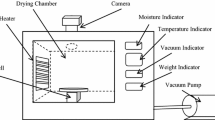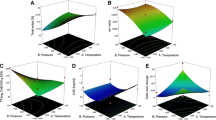Abstract
Green bell pepper was dried under vacuum-assisted microwave drying condition and the process was optimized using response surface methodology. The effect of microwave power (100–300 W) and vacuum level (200–600 mm Hg) were observed on the responses, viz. green color ratio, rehydration ratio, hardness, apparent density ratio, drying time and specific energy consumption. A central composite face-centered design was used to develop predictive regression models for the responses. Analysis of variance showed that quadratic model best fitted the experimental data. The microwave power level had greater effect on the quality attributes of green bell pepper; nevertheless at higher vacuum level the dried products had better quality. The optimum drying conditions were determined to be 284.4 W microwave power, 600 mm Hg vacuum level and the optimized value of the responses were obtained as green color ratio of 80.70%, rehydration ratio of 10.75, hardness of 152.98 N, apparent density ratio of 76.02%, drying time of 78 min, and specific energy consumption of 6.57 MJ/kg. Validation experiment was carried out at derived optimum condition to verify the prediction and adequacy of the models. Close agreement between experimental and predicted values was obtained.







Similar content being viewed by others
Abbreviations
- ADR:
-
Apparent density ratio (%)
- β :
-
Model coefficient
- D(x):
-
Desirability function
- g:
-
Gram
- GBP:
-
Green bell pepper
- GHz:
-
Gigahertz
- GR:
-
Green color ratio (%)
- kcal:
-
Kilocalorie
- M:
-
Microwave power, W
- MHz:
-
Megahertz
- RR:
-
Rehydration ratio
- RSM:
-
Response surface methodology
- SEC:
-
Specific energy consumption (MJkg-1)
- V:
-
Vacuum level, mm Hg
- VAM:
-
Vacuum-assisted microwave;
- W:
-
Watt
- X:
-
Code independent variable
- Y:
-
Code dependent variable
- i, j :
-
Indices of response variables
- k :
-
Indices of estimated model coefficient
- n :
-
Total number of responses
References
V. Kumar, S.L. Shrivastava, Int. J. Food Stud. 6(1), 67–81 (2017)
Y. Lee, L.R. Howard, B. VillalÓN, J Food Sci. 60(3), 473–476 (1995)
T.Y. Tunde-Akintunde, T.J. Afolabi, O.B. Akintunde, J. Food Eng. 68(4), 439–442 (2005)
B.I.O. Ade-Omowaye et al., J. Food Eng. 60(1), 89–98 (2003)
L. Somogyi, B. Luh, Vegetable dehydration, 2 edn. Commercial Vegetable Processing. (Van Nostrand Reinhold, New York, 1988)
K.S. Jayaraman, D.K. Das Gupta, in Drying of Fruits and Vegetables, in Handbook of Industrial Drying, 4th edn., ed. by A.S. Mujumdar (CRC Press, Boca Raton, 2014), pp. 611–635
A. Kilic, J. Food Process Eng. 40(2), e12378 (2017)
C. Scaman, T. Durance, in Combined Microwave Vacuum Drying, in Emerging Technologies for Food Processing, ed. by D. Sun, (Elsevier: Amsterdam, 2005), pp. 507–534
A.S. Mujumdar, C.L. Law, Food Bioprocess Technol. 3(6), 843–852 (2010)
I. Doymaz, O. İsmail, Food Sci. Biotechnol. 19(6), 1449–1455 (2010)
F. Kaymak-Ertekin, J. Food Sci. 67(1), 168–175 (2002)
U. S. Pal, M. K. Khan, S. N. Mohanty, Drying Technol. 26(12), 1584–1590 (2008)
D. Arslan, M. Özcan, Food Bioprod. Process. 89(4), 504–513 (2011)
S. Kaleemullah, R. Kailappan, J. Food Eng 76(4), 531–537 (2006)
A. Vega-Gálvez et al., J. Food Eng. 85(1), 42–50 (2008)
A. Vega-Gálvez et al., Food Chem. 117(4), 647–653 (2009)
E. Abano, H. Ma, W. Qu, J. Food Qual. 35(3), 159–168 (2012)
J. Yongsawatdigul, S. Gunasekaran, J. Food Process. Preserv. 20(2), 145–156 (1996)
J. Bondaruk, M. Markowski, W. Blaszczak, J. Food Eng 81(2), 306–312 (2007)
Z. W. Cui, et al., Drying Technol. 26(12), 1517–1523 (2008)
A. Figiel, J. Food Eng. 98(4), 461–470 (2010)
P. Sham, C. Scaman, T. Durance, J. Food Sci. 66(9), 1341–1347 (2001)
Z.W. Cui, S.Y. Xu, D.W. Sun, Drying Technol. 21(7), 1173–1184 (2003)
C. Kiranoudis, E. Tsami, Z. Maroulis, Drying Technol. 15(10), 2421–2440 (1997)
P. Sutar, S. Prasad, Drying Technol, 29(3), 371–380 (2011)
M. Ozdemir, et al., LWT-Food Sci. Technol. 41(10), 2044–2050 (2008)
G.E.P. Box, K.B. Wilson, in On the Experimental Attainment of Optimum Conditions, in Breakthroughs in Statistics: Methodology and Distribution, ed. by S. Kotz, N.L. Johnson (Springer, New York, 1992), pp. 270–310
B.K. Mehta et al., Appl. Math. 03(10), 8 (2012)
P. S. Madamba, LWT Food Sci. Technol. 35(7), 584–592 (2002)
C. Liyana-Pathirana, F. Shahidi, Food Chem. 93(1), 47–56 (2005)
I. Eren, F. Kaymak-Ertekin, J. Food Eng. 79(1), 344–352 (2007)
A. Datta, Fundamentals of heat and moisture transport for microwaveable food product and process development. In Handbook of microwave technology for food applications, ed. by R. Anantheswaran (Marcel Dekker, New York, 2001), pp. 115–172
J. Lee et al., J. Food Compos. Anal. 13(1), 45–57 (2000)
D.C. Montgomery, Design and Analysis of Experiments: Graph. Darst. (John Wiley & Sons, New York, 1984)
S. Giri, S. Prasad, 25(5), 901–911 (2007)
A. Chauhan, A. Srivastava, Drying Technol. 27(6), 761–769 (2009)
D. Kumar, S. Prasad, G.S. Murthy, J. Food Sci. Technol. 51(2), 221–232 (2014)
S. Giri, S. Prasad, Int. J. Food Prop. 9(3), 409–419 (2006)
G. Sharma, S. Prasad, J. Food Eng. 50(2), 99–105 (2001)
R. Myers, D. Montgomery, Response Surface Methodology: Process and Product Optimization Using Designed Experiments. (Wiley, New York, 1995)
O. Alves-Filho et al., Dehydration of Green Peas Under Atmospheric Freeze-Drying Conditions. (XIV Simposio Internacional de Secado, São Paulo, 2004)
R. Guiné, et al., 9° Encontro de Química dos Alimentos 2009, 4–4, (2009)
A. Marabi et al., J. Food Eng. 72(3), 211–217 (2006)
P.P. Lewicki, J. Food Eng. 36(1), 81–87 (1998)
Author information
Authors and Affiliations
Corresponding author
Rights and permissions
About this article
Cite this article
Kumar, V., Shrivastava, S.L. Optimization of vacuum-assisted microwave drying parameters of green bell pepper using response surface methodology. Food Measure 11, 1761–1772 (2017). https://doi.org/10.1007/s11694-017-9557-7
Received:
Accepted:
Published:
Issue Date:
DOI: https://doi.org/10.1007/s11694-017-9557-7




